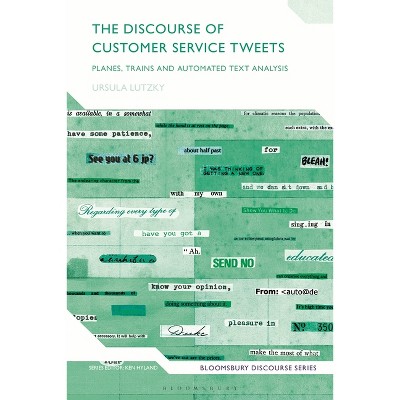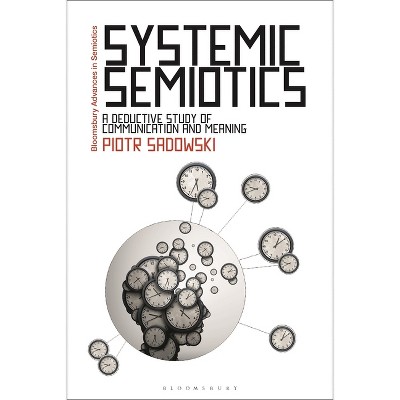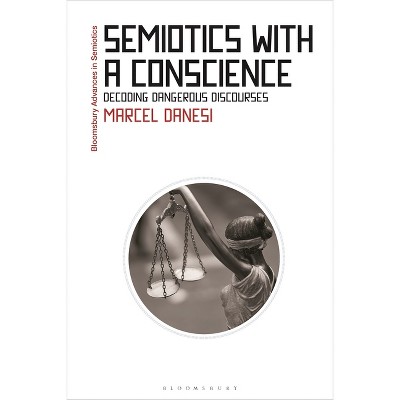Developing a Neo-Peircean Approach to Signs - (Bloomsbury Advances in Semiotics) by Tony Jappy

$130.99 when purchased online
Target Online store #3991
About this item
Highlights
- This book takes up a number of Charles Sanders Peirce's undeveloped semiotic concepts and highlights their theoretical interest for a general semiotics.
- About the Author: Tony Jappy is Honorary Professor of English Linguistics and Semiotics at the University of Perpignan Via Domitia, France.
- 216 Pages
- Literary Criticism, Semiotics & Theory
- Series Name: Bloomsbury Advances in Semiotics
Description
About the Book
"Peirce's career as a logician spanned almost half a century, during which time he produced several increasingly complex sign systems. The best-known, from 1903, defined amongst other things a signifying process involving sign, object and interpretant, the universally-known icon-index-symbol division and a set of 10 distinct classes of signs. Peirce subsequently expanded this process to include 2 objects, the sign and 3 interpretants. Uncoincidentally, in the 5 years between 1903 and the final system of 1908, he introduced a number of highly innovative semiotic concepts which he never developed. One such concept is hypoiconicity, which comprises 3 levels of isomorphism holding between sign and object and, in spite of the mutations these varieties of icon subsequently underwent, offers qualitative analysis as a complement to the traditional literal-figurative binarism in the discussion of verbal and nonverbal signs. Another is semiosis, which Peirce introduced and defined in 1907 but only rarely illustrated. Involving a complex combination of object, perception, interpretation and a medium, this is shown to be a far more complex signifying process than the one implicit in the three-correlate definition of the sign of 1903. Exploring the evolving theoretical background to the emergence of these new concepts and showing how they differ from certain contemporary conceptions of sign, mind and signification, the book proposes an introduction to, and explanations and illustrations of, these important developments." --Book Synopsis
This book takes up a number of Charles Sanders Peirce's undeveloped semiotic concepts and highlights their theoretical interest for a general semiotics.Peirce's career as a logician spanned almost half a century, during which time he produced several increasingly complex sign systems. The best-known, from 1903, defined amongst other things a signifying process involving sign, object and interpretant, the universally-known icon-index-symbol division and a set of 10 distinct classes of signs. Peirce subsequently expanded this process to include 2 objects, the sign and 3 interpretants. Uncoincidentally, in the 5 years between 1903 and the final system of 1908, he introduced a number of highly innovative semiotic concepts which he never developed.
One such concept is hypoiconicity, which comprises 3 levels of isomorphism holding between sign and object and, in spite of the mutations these varieties of icon subsequently underwent, offers qualitative analysis as a complement to the traditional literal-figurative binarism in the discussion of verbal and nonverbal signs. Another is semiosis, which Peirce introduced and defined in 1907 but only rarely illustrated. Involving a complex combination of object, perception, interpretation and a medium, this is shown to be a far more complex signifying process than the one implicit in the three-correlate definition of the sign of 1903. Exploring the evolving theoretical background to the emergence of these new concepts and showing how they differ from certain contemporary conceptions of sign, mind and signification, the book proposes an introduction to, and explanations and illustrations of, these important developments.
Review Quotes
A very serious and ausführlicheresearch.
About the Author
Tony Jappy is Honorary Professor of English Linguistics and Semiotics at the University of Perpignan Via Domitia, France.Dimensions (Overall): 9.21 Inches (H) x 6.14 Inches (W) x .5 Inches (D)
Weight: 1.04 Pounds
Suggested Age: 22 Years and Up
Number of Pages: 216
Genre: Literary Criticism
Sub-Genre: Semiotics & Theory
Series Title: Bloomsbury Advances in Semiotics
Publisher: Bloomsbury Publishing PLC
Format: Hardcover
Author: Tony Jappy
Language: English
Street Date: January 25, 2024
TCIN: 90911004
UPC: 9781350288812
Item Number (DPCI): 247-03-9601
Origin: Made in the USA or Imported
Shipping details
Estimated ship dimensions: 0.5 inches length x 6.14 inches width x 9.21 inches height
Estimated ship weight: 1.04 pounds
We regret that this item cannot be shipped to PO Boxes.
This item cannot be shipped to the following locations: American Samoa (see also separate entry under AS), Guam (see also separate entry under GU), Northern Mariana Islands, Puerto Rico (see also separate entry under PR), United States Minor Outlying Islands, Virgin Islands, U.S., APO/FPO
Return details
This item can be returned to any Target store or Target.com.
This item must be returned within 90 days of the date it was purchased in store, shipped, delivered by a Shipt shopper, or made ready for pickup.
See the return policy for complete information.

![Introduction to the Semiotics of the Text - (Semiotics, Communication and Cognition [Scc]) by Gianfranco Marrone (Paperback)](https://target.scene7.com/is/image/Target/GUEST_9627e70a-772d-4931-8243-efa36e3a9659)



![The Natural History of the Sign - (Semiotics, Communication and Cognition [Scc]) by Chris Barnham (Paperback)](https://target.scene7.com/is/image/Target/GUEST_9c4811ca-af87-4aad-a086-3f0346f0876a)





